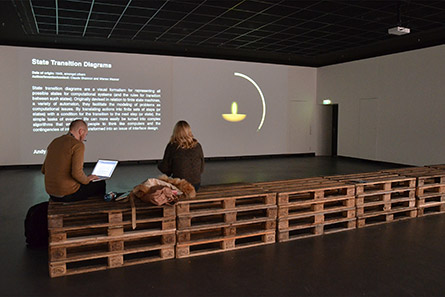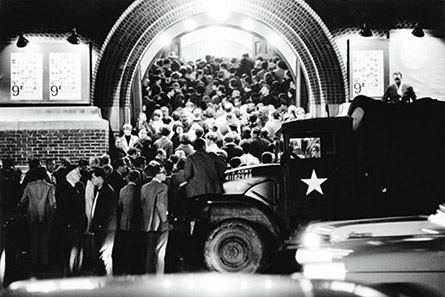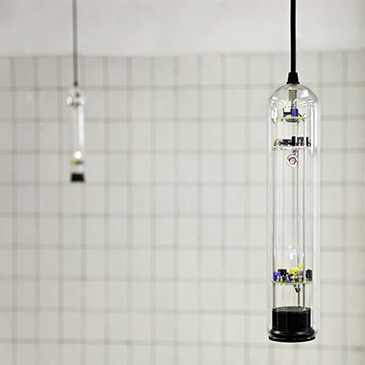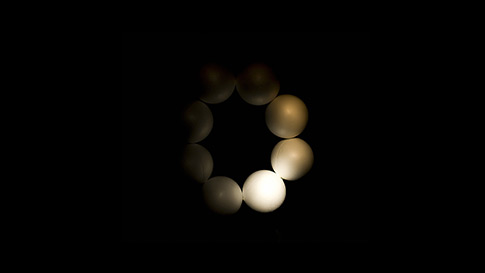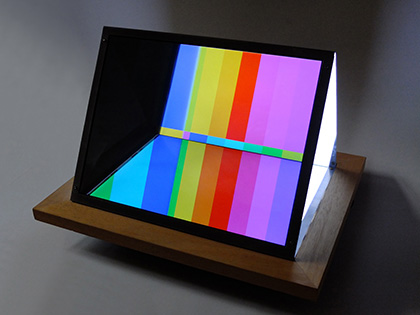BERLIN, ARTS TECHNOLOGIES AND EVENTS
by Dominique Moulon [ April 2013 ]
In Berlin in winter, two events focus on research and practices between the arts and technology: the Transmediale and the CTM Festival. But it is also an opportunity to have a look at some of the works in the exhibitions at the Hamburger Bahnhof, at the KW Institute for Contemporary Art, at the LEAP or Lab for Electronic Arts and Performance, before ending up at the DAM Gallery.

The Transmediale Festival
Telekommunisten,
“OCTO P7C-1”, 2013,
© Jonas Frankki.
 I
I remember arriving in Berlin in 2006 for the
Transmediale Festival. It was at the Akademie der Künste, when it was still a question of emerging artistic practices. The planet Pluto was being reconsidered at the time by the International Astronomical Union and so newly categorised as a dwarf, while the Internet was becoming more and more participative. The characters B,W,P,W,A and P (Back When Pluto Was A Planet) that adorn the Haus der Kulturen der Welt refer to this immediate past by inciting us to measure the growing impact of the digital on our societies. Social issues were in fact at the heart of the many conferences of this Transmediale 2013. But theorists and researchers could not ignore the gigantic yellow plastic octopus that members of the
Telekommunisten collective set up in the interior of the HKW. “OCTO P7C-1” is a tubular apparatus of forced air evoking the pneumatic postal systems that were developed during the second half of the 19th century. Through this, the absolute power of the operators who establish connections can be measured in a world where a few rare powers, which are essentially private, keep an eye on our data and personal correspondence.

A cabinet of curiosities
Graham Harwood
& Matsuko Yokokoji,
“Evil MediaDistribution Centre”,
2013, © Juan Quinones.
 T
The organisation of the exhibition “Evil Media Distribution Centre” was entrusted to the artists
Matsuko Yokokoji and
Graham Harwood. Conceived in reaction to the book “Evil Media” recently published by Matthew Fuller and Andrew Goffey, it has the look of a cabinet of curiosities. We can discover there the contributions of 66 artists by means of as many textual descriptions of objects of “grey media”, a concept borrowed from the authors of the book “Evil Media”. Graham Harwood describes the automatic telephone changeover switch invented by Almon Strowger in 1891. Strowger, who was a funeral home director in the United States, had the idea for this innovation after suspecting the local telephone operator, who was none other than the wife of his direct competitor, of depriving him of potential clients. Graham Harwood tells us these automatic changeover switches were only recently replaced with digital technology, the same ones that allow certain companies of the Nasdac today to spy on even our most menial exchanges.

At the Hamburger Bahnhof
9 Evenings, “Opening”,
1966, © Robert McElroy,
VAGA NYC.
 Y
You have to cross the Spree River to go from the HKW to the
Hamburger Bahnhof where the exhibition “9 Evenings: Theatre and Engineering” is being held, organised in New York in October 1966 by the artist Robert Rauschenberg and the Bell Telephone Labs engineer, Billy Klüver. The performance entitled “Open Score” that Rauschenberg conceived with the complicity of the engineer Jim McGee, begins with a tennis match opposing Mimi Kanarek and Frank Stella. But Bill Kaminski equipped the rackets beforehand with wireless microphones by so that they would resonate within the Armoury of the 69th regiment, conceived initially for this sport. In addition, the light diminishes gradually, impact after impact, till the space is entirely black at which point, nearly five hundred people, filmed with infrared cameras, invade the court following Rauschenberg’s directions. This now historic performance illustrates the inevitable penetration of technology into art, while waiting for the recognition of emerging artistic practices initiated nearly fifty years ago.

Lab for Electronic Arts and Performance
Verena Friedrich,
“Transducers”, 2009,
© Max Schroeder.
 T
The
LEAP (Lab for Electronic Arts and Performance), situated a few steps from the Alexanderplatz, is an associative project situated in the continuity of the Experiments in Art and Technology, an organisation that itself is a follow up to 9 Evenings. Associated for the occasion with the Transmediale and CTM festivals, LEAP presents an exhibition on the theme of “Abstract Worlds”. It is the opportunity to discover “Transducers” by
Verena Friedrich. This installation, which has already travelled the world, hinges on very little - just a few hairs; hairs that come from different individuals, each one as insignificant as the other, though each expressing the singularities that are common to all of us. Yet it is precisely these singularities that express themselves in glass tubes where they vibrate and so resonate throughout the gallery. The vibrating sounds accord and come into tune with one another to make music that is comparable to that of La Monte Young, extending endlessly to the smallest recesses of the environment, which itself becomes part of the work.

At the KW Institute
Yoko Ono,
“Telephone Piece”,
1971-2012,
© Uwe Walter.
 T
The exhibition “One on One” at the
KW Institute for Contemporary Art brings together 17 installations that can only be appreciated by a single spectator at a given moment. They are, for the most part, inside little rooms even though there is also a fixed line telephone on a white table. A direct line with the artist
Yoko Ono, who the mediator tells us will call without saying when. She adds that Yoko calls every day, at least once or twice. So there are spectators who await the call of she who has more than three million followers on Twitter. It is a strange museum situation, by absence, this possible uncontrolled exchange when we are all convinced of being constantly connected to the entire world. But is not this work, apart from its relative obsolescence, stranger today than it was yesterday when “Pluto was still a planet”, when we couldn’t imagine ever being friends with all the Yoko Ono’s on Facebook; before even certain fame being finally accessible for all?

At the CTM Festival
Constant Dullaart,
“Youtube as a sculpture”,
2009.
 T
The main exhibition of the
CTM Festival for the past few years has been held at the Bethanien in Kreuzberg. It brings together a few, primarily digital artworks, among which are those of
Constant Dullaart whose practices follow in the line of Marcel Duchamp. “Terms of Service” could be considered a ready made because it’s a Google page that is video projected. But it takes on the appearance of a face dictating the American company’s terms of service, dating from 2012. The synthesised voice, which is rather authoritative, tells us what we ought to know, for example: “We may review content to determine whether it is illegal or violates our policies, and we may remove or refuse to display content that we reasonably believe violates our policies or the law”. But what in fact constitutes a “reasonable belief”? Or, “By using our Services, you agree that Google can use such data in accordance with our Privacy Policies.” Ours? Carrying on in line with Duchampien practices, there is a series of sequences entitled “YouTube as a subject” that hacks the previous interface of the online video giant.

Subject, medium and support all at once
Ben Coonley,
“7 Responses to Constant Dullaart's "YouTube as a Subject””, 2008.
 S
Several artists, starting back in 2008, appropriated the aesthetic of the YouTube video player, among them
Ben Coonley with his “7 Responses to Constant Dullaart's "YouTube as a Subject””. The two series at the Kunstraum Kreuzberg dialogue and answer one another face to face. As for the spectators, they can then observe what they’ve already seen so many times without really paying attention. There’s a surprise for each adaptation. All the sequences begin just as they would normally, but then seem to be freed, through the animation, from the design of their creators. All of these works are of course visible online on YouTube’s server, as they ought to be. A total fusion between the subject, the medium and support is thus at work here. For Constant Dullaart and Ben Coonley, digital technology offers a lot more than a palette of tools or a simple “increase in productivity”, not to mention its “misappropriation”, which is at the centre of so many artistic trends from Fluxus to the New Realists.

The Dam Gallery
Flavien Thery,
“Les contraires”, 2009.
 W
Wolf Lieser, who is the founder of the
DAM Gallery in Berlin, is exhibiting his cabinet of curiosities (Wunderkammer in German) at the gallery. And there is among the digital works being presented, the piece by
Flavien Thery entitled, “Les contraires”. It is a kind of coloured prism with the look of a re-composed screen whose appearance changes depending on the point of view, as it does in sculpture. By disassociating the light source from the screen’s filter, the French artist, whose work focuses on the relationship between art and science, invites the spectator to move around in the space. This piece, which questions vision, corresponds entirely to the constructions in perspective that the Italian Humanists of the Renaissance collected in their studioli. “Where is the information that makes the coloured surfaces vary on the plane, in space or at the source?” asks the observer scrutinising the sculptural object whose artistic qualities are inherent to the pertinence of the questions it raises. Because it is the observer who, in moving about in space, makes the work, while the work itself in exchange, questions the observer via its multiple realities.

Written by Dominique Moulon for Digitalarti and translated by Geoffrey Finch, April 2013.

